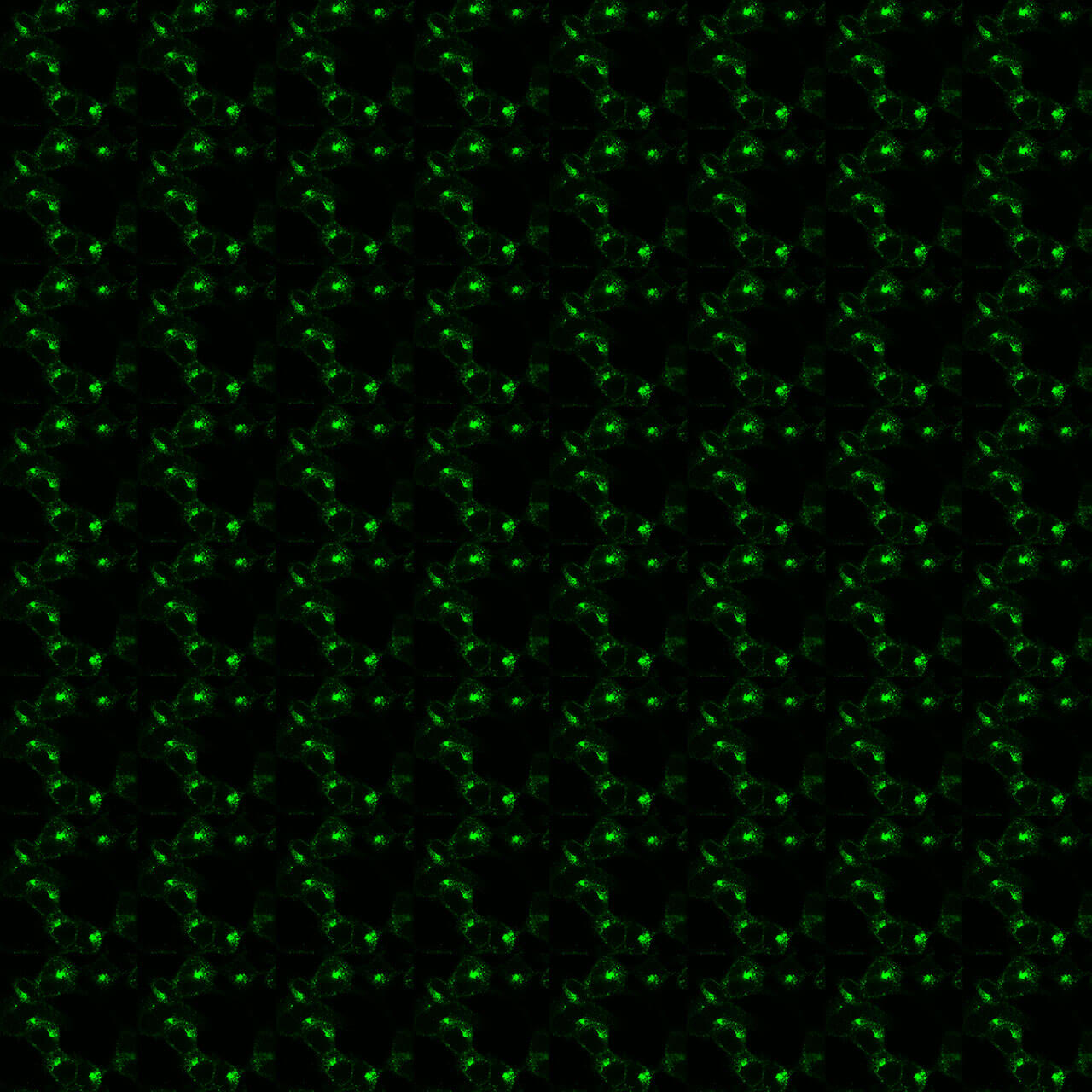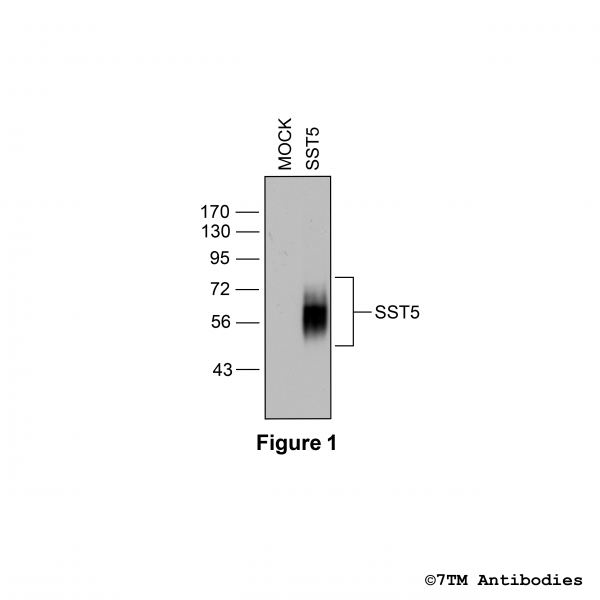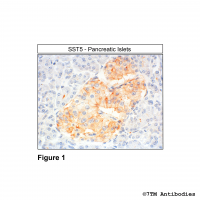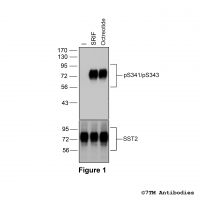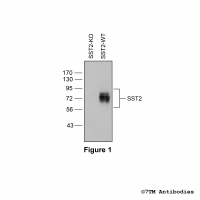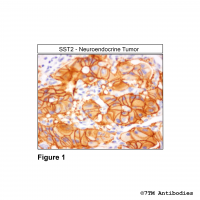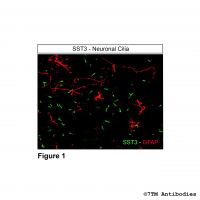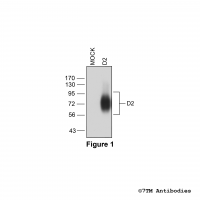Prices plus VAT plus shipping costs
Ready to ship today,
Delivery time appr. 5-8 days
- Order number: 7TM0359N
- Content: 100 µl
- Host: Rabbit
The non-phospho-SST5 receptor antibody is directed against the distal end of the carboxyl-terminal tail of human SST5. In can be used to detect total SST5 receptors in Western blots independent of phosphorylation. The non-phospho-SST5 antibody can also be used to isolate and enrich SST5 receptors from tissue and cell lysates. It also detects SST5 in cultured cells and tissue sections by immunohistochemistry. The non-phospho-SST5 antibody has been validated using siRNA knockdown (KO-Validated).
| Alternative Names | SST5, SSTR5, Somatostatin Receptor 5 |
| IUPHAR Target ID | 359 |
| UniProt ID | P35346 |
| Western Blot (WB) | 1:1000 |
| Immunocytochemistry (ICC) | 1:200 |
| Immunohistochemistry (IHC) | 1:100 |
| Species Reactivity | Human |
| Host / Isotype | Rabbit / IgG |
| Class | Polyclonal |
| Immunogen | A synthetic peptide with sequence QEATPPAHRRAAANGLMQTSKL corresponds to amino acids 344-364 in human SST3 |
| Form | Liquid |
| Purification | Antigen affinity chromatography |
| Storage buffer | Dulbecco's PBS, pH 7.4, with 150 mM NaCl, 0.02% sodium azide |
| Storage conditions | short-term 4°C, long-term -20°C |
Figure 1. Validation of the Somatostatin Receptor 5 in transfected HEK293 cells. Native HEK293 cells (MOCK) or HEK293 cells stably expressing the Somatostatin Receptor 5 (SST5) were lysed and immunoblotted with the phosphorylation-independent anti-SST5 antibody (7TM0359N-WB) at a dilution of 1:1000.
Figure 2. Western blot analysis of Somatostatin Receptor 5 in neuroendocrine tumors. Human tumor samples (T1, T2) from neuroendocrine tumors were homogenated and immunoblotted using anti-SST5 (non-phospho-Somatostatin-Receptor 5) antibody (7TM0359N-WB) at a dilution of 1:1000.
Figure 3. Immunocytochemical identification of Somatostatin Receptor 5 in transfected HEK293 cells. Native HEK293 cells (MOCK) or HEK293 cells stably expressing the Somatostatin Receptor (SST5) were immunocytochemically stained with anti-SST5 (non-phospho-Somatostatin Receptor 5) antibody (7TM0359N-WB) at a dilution of 1:200. Note, SST5 receptors were confined to the plasma membrane in tranfected cells.
Figure 4. Immunohistochemical identification of Somatostatin Receptor 5 in human pancreatic islets. Sections were dewaxed, microwaved in citric acid, and incubated with anti-SST5 (non-phospho-Somatostatin Receptor 5) antibody (7TM0359N-WB) at a dilution of 1:100. Sections were then sequentially treated with biotinylated anti-rabbit IgG and avidin-biotin solution.Color was developed by incubation in 3-amino-9-ethylcarbazole (ACE), and sections were counterstained with hematoxylin. Note, SST5 receptors were detected at the plasma membrane of nearly all cells in human pancreatic islets.
Figure 5. Immunohistochemical identification of Somastatin Receptor 5 in human anterior pituitary. Sections were dewaxed, microwaved in citric acid, and incubated with anti-SST5 (non-phospho-Somatostatin Receptor 5) antibody (7TM0359N-WB) at a dilution of 1:100. Sections were then sequentially treated with biotinylated anti-rabbit IgG and avidin-biotin solution.Color was developed by incubation in 3-amino-9-ethylcarbazole (ACE), and sections were counterstained with hematoxylin. Note, SST5 receptors were detected on a distinct population of cells in the anterior pituitary.
Figure 6. Immunohistochemical identification of Somastatin Receptor 5 in human growth-hormone-producing pituitary adenoma tissue. Sections were dewaxed, microwaved in citric acid, and incubated with anti-SST5 (non-phospho-Somatostatin Receptor 5) antibody (7TM0359N-IC) at a dilution of 1:100. Sections were then sequentially treated with biotinylated anti-rabbit IgG and avidin-biotin solution. Color was developed by incubation in 3-amino-9-ethylcarbazole (ACE), and sections were counterstained with hematoxylin. Note, SST5 receptors were uniformly detected at the plasma membrane of nearly all tumor cells.
Figure 7. Immunohistochemical identification of Somastatin Receptor 5 in human pheochromocytoma. Sections were dewaxed, microwaved in citric acid, and incubated with anti-SST5 (non-phospho-Somatostatin Receptor 5) antibody (7TM0359N-IC) at a dilution of 1:100. Sections were then sequentially treated with biotinylated anti-rabbit IgG and avidin-biotin solution.Color was developed by incubation in 3-amino-9-ethylcarbazole (ACE), and sections were counterstained with hematoxylin. Note, SST5 receptors were uniformly detected at the plasma membrane of nearly all cells in pheochromocytoma.

